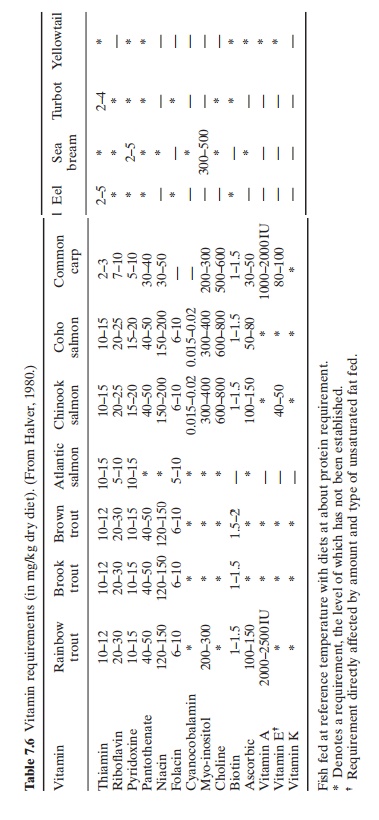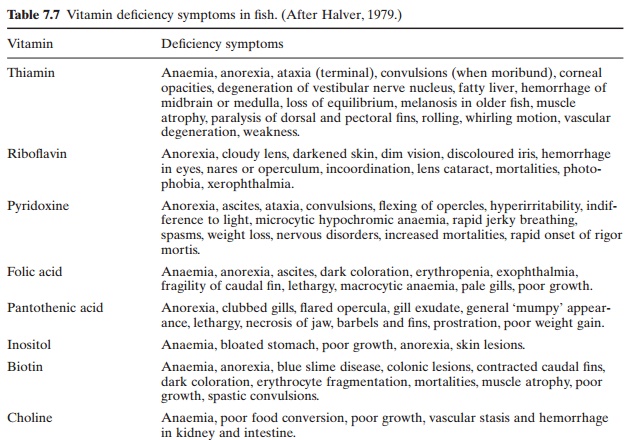Chapter: Aquaculture Principles and Practices: Nutrition and Feeds
Vitamins - Aquaculture: Energy requirements and sources
Vitamins
Vitamins are a chemically diverse group of organic substances that are
either not synthesized by organisms or are synthesized at rates insufficient to
meet the organisms’ needs. They constitute only a minute fraction of the diet
and are more catalytic in their function, but are critical for the maintenance
of normal metabolic and physicological functions. They can be classified into
two groups: water-soluble and fat-soluble vitamins. Water-soluble vitamins
include eight members of the vitamin B complex:thiamin,riboflavin,pyridoxine,pantothenic
acid, niacin, biotin, folic acid and vitamin B12. They include the essential
nutritional factors choline, inositol and ascorbic acid, and vitamins with
less-defined activities for fish: p-aminobenzoic
acid,lipoic acid and citrin.The fat-soluble group comprises vitamins A,D,E and
K.
The information available on vitamin nutrition of aquatic animals is
limited. The leaching of water-soluble vitamins from test diets, before the
animals feed on them has been a major problem in determining their
requirements. This is more so in the case of crustaceans because of their slow
feeding habits, and in the case of molluscs because they feed on algae and
other natural food. Much of the available information is based on the work done
on salmonids, but some data are also available for a few other species, and
these are presented in Table 7.6. If natural food organisms are available to
cultured animals, as in extensive pond culture, prepared feed may not need any
vitamin supplements. On the contrary, in intensive farming, where natural food
items do not contribute much to dietary intake, the addition of adequate
quantities of vitamins will be essential. Insufficient information often makes
it difficult to decide with precision the quantities which should be added.
Hypervitaminosis is rare in fish, although it is possible at very high levels
(for example excess vitamin A causes enlargement of liver and spleen, abnormal
growth and bone formation and epithelial keritonization), particularly with the
fatsoluble

vitamins. Generally, vitamin levels in prepared feeds are sufficiently
high that even with processing, storage and leaching losses the remaining
levels meet requirements.
The deficiency symptoms for most of the water-soluble vitamins have been
described(Halver, 1979) (Table 7.7). The symptomatic results of these
deficiencies were observed in fish that had been grown on test diets devoid of
an individual vitamin. The functions of these vitamins are also beginning to be
understood. For example, thiamin deficiency produces char-


acteristic symptoms, including nervous system damage. As thiamin is
involved in carbohydrate metabolism, thiamin needs were expected to be
correlated with dietary levels of carbohydrates, and this has been shown to be
so in common carp. Riboflavin also has a variety of coenzyme functions in
carbohydrate metabolism, and its absence from the diet produces symptoms
generally associated with the eye. Dietary deficiencies of folacin and vitamin
B12 in fish are expressed as anaemias. Folic acid primarily functions in
purine synthesis, and deficient purine synthesis strikes most directly at
nucle-oprotein production in blood cell formation, causing a macrocytic, normochromic
anaemia. Severe choline deficiency impairs lipid metabolism and leads to fatty
livers. Choline is usually needed in much larger amounts than water-soluble
vitamins, because of its role in phos-pholipid synthesis needed for cell
membrane structure. Myoinositol is also required in larger amounts, as it is
also probably needed as a constituent of phospholipids. Vitamin C deficiencies
in fish often cause spinal deformities and slow wound repair, because of slow
collagen formation.
As has been pointed out earlier, there is very little definite
information available at present on vitamin requirements of crustaceans and
molluscs. Even where requirements have been demonstrated, the deficiency
symptoms have been defined only as reduced growth. No evidence has been found
to show the physiological role of any of the fat-soluble vitamins by
crustaceans. A dietary sourceof thiamin and pyridoxine, as well as inositol,
has been shown to promote growth in Penaeusjaponicus.
Similarly, choline also appears to benecessary for improved growth and
survival. The American lobster (Homarus
americanus) has an apparent requirement for choline. Lack of
choline-containing phospholipids results in a characteristic deficiency
syndrome, in which juvenile mortalities are associated with unsuccessful molts
(D’Abramo et al., 1981a,b).
For the Japanese shrimp (P.
japonicus) the required dietary levels of vitamins have been tentatively
established as thiamin 120 mg/kg, pyridoxine 120 mg/kg, choline 600 mg/kg,
inositol 2000 mg/kg and ascorbic acid 10 000 mg/kg (Castell et al., 1986).
Related Topics